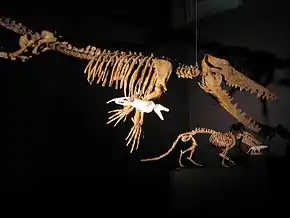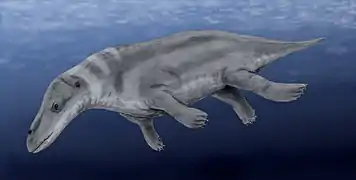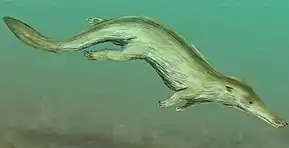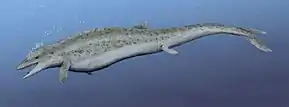Liste d'espèces et de genres de cétacés éteints
La liste des cétacés éteints présente les genres éteints et les espèces de l'ordre des cétacés. Les cétacés (les baleines, les dauphins et les marsouins) sont descendants de mammifères terrestres, les artiodactyles. Ces premiers cétacés deviennent progressivement mieux adaptés pour la natation que pour la marche sur la terre, évoluant finalement vers des cétacés entièrement marins.
Cette liste comprend actuellement uniquement les genres et les espèces fossiles. Cependant, la population atlantique des baleines grises (Eschrichtius robustus) est devenue éteinte au XVIIIe siècle, et le dauphin de Chine ou baiji (ou le dauphin de la rivière chinoise, Lipotes vexillifer) a été déclaré « fonctionnellement éteinte » après qu'une expédition à la fin de 2006 n'a réussi à trouver aucun individu de l'espèce dans le fleuve Yang-Tsé.
Sous-ordre des Archaeoceti
Famille des Basilosauridae
(Éocène supérieur)

- Basilosaurinae
- Basilosaurus
- Basiloterus
- Eocetus
- Platyosphys
- Dorudontinae
- Ancalecetus
- Chrysocetus
- Cynthiacetus
- Dorudon
- Masracetus
- Ocucajea
- Saghacetus
- Supayacetus
- Zygorhiza
- Stromeriinae
- Stromerius[1]
Famille des Pakicetidae
(Éocène inférieur à Éocène moyen)

- Gandakasia
- Pakicetus
- Nalacetus
- Ichthyolestes
Famille des Protocetidae
(Éocène)

- Georgiacetinae
- Babiacetus
- Carolinacetus
- Georgiacetus
- Natchitochia
 Squelette de Maiacetus
Squelette de Maiacetus - Pappocetus
- Pontobasileus
- Makaracetinae
- Makaracetus
- Protocetinae
- Aegyptocetus
- Artiocetus[2]
- Crenatocetus
- Dhedacetus[3]
- Gaviacetus
- Indocetus
 Kutchicetus minimus (reconstitution)
Kutchicetus minimus (reconstitution) - Kharodacetus[3]
- Maiacetus
- Protocetus
- Qaisracetus
- Rodhocetus
- Takracetus
- Togocetus[4]
Famille des Remingtonocetidae
(Éocène)
- Andrewsiphius
- Attockicetus
- Dalanistes
- Kutchicetus
- Rayanistes[5]
- Remingtonocetus
Sous-ordre des Mysticeti
Famille des Aetiocetidae

- Aetiocetus
- Ashorocetus
- Chonecetus
- Fucaia[6]
- Morawanocetus
- Willungacetus
Famille des Llanocetidae
(Éocène supérieur et Oligocène)
- Llanocetus
- Mystacodon (anciennement rattaché aux Mystacodontidae[7])
Famille des Mammalodontidae
(synonyme junior des Janjucetidae)

(Oligocène supérieur)
- Janjucetus
- Mammalodon
Famille des Mystacodontidae
(Éocène supérieur) Ancienne famille monotypique du genre Mystacodon aujourd'hui rattaché aux Llanocetidae[7].
Famille des Cetotheriopsidae
(Oligocène à Miocène)
- Cetotheriopsis
Famille des Eomysticetidae
(Oligocène)
- Eomysticetus
- Matapanui
- Micromysticetus
- Tohoraata
- Tokarahia
- Waharoa
- Yamatocetus
Famille des Balaenidae
(Oligocène à Actuel)
- Balaena
- Balaenella
- Balaenotus
- Balaenula
- Eubalaena (extant)
- Idiocetus
- Morenocetus
- Peripolocetus
- Protobalaena
Clade des Thalassotherii
- Cetotheriomorphus
- Heterocetus
- Isocetus
- Notiocetus
- Palaeobalaena
- Rhegnopsis
Famille des Cetotheriidae
(Miocène à Pliocène)
Classification selon Steeman en 2007[8].

Famille des Balaenopteridae
(Miocène à Actuel)
- Archaebalaenoptera
- Balaenoptera (extant)
- "Balaenoptera" cortesii
- "Balaenoptera" portisi
- "Balaenoptera" ryani
- Burtinopsis
- Cetotheriophanes
- Fragilicetus[15]
- Incakujira
- Parabalaenoptera
- Plesiobalaenoptera
- Plesiocetus
- Praemegaptera
- Protororqualus
Famille des Diorocetidae
(Miocène à Pliocène)
- Amphicetus
- Diorocetus
- Plesiocetopsis
- Thinocetus
- Uranocetus
Famille des Eschrichtiidae
(Miocène à Actuel)
- Archaeschrichtius
- Eschrichtioides
- Gricetoides
- Megapteropsis
Sous-ordre des Odontoceti
Famille des Ashleycetidae
(Oligocène inférieur)
- Ashleycetus
Famille des Patriocetidae
(Oligocène au Miocene inférieur )
- Patriocetus
Famille des Simocetidae
(Oligocène supérieur)
- Simocetus
Famille des Xenorophidae
(Oligocène)
- Albertocetus
- Archaeodelphis
- Cotylocara
- Echovenator[20]
- Xenorophus
Famille des Dalpiazinidae
(Oligocène supérieur à Miocène)
- Dalpiazina
Famille des Squalodontidae
- Austrosqualodon
- Eosqualodon
- Macrophoca
- Pachyodon
- Phoberodon
- Squalodon (syn. Kelloggia, Rhizoprion, Crenidelphinus, Arionius, Phocodon)
- Smilocamptus
- Tangaroasaurus
Famille des Kogiidae
(Miocène à Actuel)
- Aprixokogia
- Kogia (extant)
- Nanokogia
- Praekogia
- Scaphokogia
- Thalassocetus
Famille des Physeteridae
- Aulophyseter
- Diaphorocetus
- Ferecetotherium
- Idiophyseter
- Idiorophus
- Orycterocetus
- Physeterula
- Placoziphius
- Preaulophyseter
Famille incertae sedis
- Acrophyseter
- Albicetus
- Brygmophyseter
- Eudelphis
- Helvicetus (nomen dubium)
- Hoplocetus (nomen dubium)
- Kogiopsis
- Livyatan[22]
- Miokogia (nomen dubium)
- Paleophoca (nomen dubium)
- Placoziphius
- Prophyseter (nomen dubium)
- Scaldicetus (nomen dubium)
- Zygophyseter
Famille des Argyrocetidae
(Oligocène supérieur à Miocène inférieur)
- Argyrocetus
- Chilcacetus
- Macrodelphinus
Famille des Eoplatanistidae
(Miocène)
- Eoplatanista
Famille des Eurhinodelphinidae
(Miocène moyen au Pliocène)

- Ceterhinops
- Eurhinodelphis
- Iniopsis
- Mycteriacetus
- Phocaenopsis
- Schizodelphis
- Vanbreenia
- Xiphiacetus
- Ziphiodelphis
Super-famille des Platanistoidea
- Awamokoa[23]
Famille des Allodelphinidae
(Miocène inférieur à moyen)

Famille des Platanistidae
(Miocène à Actuel)
- Araeodelphis
- Dilophodelphis
- Pachyacanthus
- Pomatodelphis
- Prepomatodelphis
- Zarhachis
Famille des Squalodelphinidae
(Miocène inférieur à supérieur)
- Huaridelphis[25]
- Medocinia
- Notocetus
- Phocageneus
- Squalodelphis
Famille des Squaloziphiidae
(Miocène inférieur)
- Squaloziphius
Famille des Ziphiidae
(Miocène à Actuel)
- Formes basales
- Aporotus
- Beneziphius
- Chavinziphius
- Chimuziphius
- Choneziphius
- Dagonodum
- Globicetus
- Imocetus
- Messapicetus
- Ninoziphius
- Notoziphius
- Tusciziphius
- Ziphirostrum
- Sous-famille des Berardiinae
- Archaeoziphius
- Microberardius
- Sous-famille des Hyperoodontinae
- Africanacetus
- Ihlengesi
- Khoikhoicetus
- Mesoplodon (extant)
- Nenga
- Pterocetus
- Xhosacetus
- Sous-famille des Ziphiinae
- Caviziphius
- Izikoziphius
- Nazcacetus
- Sous-famille incertae sedis
- Anoplonassa
- Belemnoziphius
- Cetorhynchus
- Eboroziphius
- Pelycorhamphus
Famille des Albireonidae
(Miocène à Pliocène)
- Albireo
Famille des Delphinidae

(Oligocène à Actuel)
- Arimidelphis
- Astadelphis
- Australodelphis
- Delphinus (actuel)
- Delphinus domeykoi
- Eodelphinus
- Etruridelphis
- Hemisyntrachelus
- Lagenorhynchus (actuel)
- Lagenorhynchus harmatuki
- Orcinus (actuel)
- Orcinus citoniensis
- Orcinus paleorca
- Platalearostrum[28]
- Protoglobicephala
- Pseudorca (actuel)
- Pseudorca yokoyamai
- Septidelphis[29]
- Sinanodelphis
- Stenella (actuel)
- Stenella rayi
- Tursiops (actuel)
- Tursiops osennae
Famille des « Kentriodontidae »
(Miocène inférieur à moyen)

- Atocetus
- Belonodelphis
- Hadrodelphis
- Kentriodon
- Lamprolithax
- Leptodelphis
- Liolithax
- Lophocetus
- Loxolithax
- Nannolithax
- Macrokentriodon
- Microphocaena
- Pithanodelphis
- Rudicetus
- Sarmatodelphis
- Sophianacetus
- Tagicetus
Famille des Phocoenidae
(Miocène à Actuel)
- Archaeophocaena
- Australithax
- Brabocetus
- Haborophocoena
- Lomacetus
- Miophocaena
- Numataphocoena
- Piscolithax
- Pterophocaena
- Salumiphocaena
- Semirostrum[30]
- Septemtriocetus
Famille incertae sedis
- Anacharsis
- Delphinavus
- Graamocetus
- Miodelphis
- Oedolithax
- Oligodelphis
- Palaeophocaena
- Platylithax
- Prionodelphis
- Protodelphinus
Famille des Iniidae
- Goniodelphis
- Hesperoinia
- Ischyrorhynchus
- Isthminia
- Meherrinia
- Saurocetes
Famille des Pontoporiidae
(Miocène moyen à Actuel)
- Auroracetus
- Brachydelphis
- Pliopontos
- Pontistes
- Protophocaena
- Stenasodelphis
Super-famille incertae sedis
- Delphinodon
- Heterodelphis
Famille incertae sedis
- Acrodelphis
- Agriocetus
- Atropatenocetus (Oligocène)
- Champsodelphis
- Hesperocetus
- Imerodelphis (Miocène)
- Kharthlidelphis
- Lonchodelphis
- Macrochirifer
- Microcetus
- Microsqualodon
- Microzeuglodon
- Neosqualodon
- Pelodelphis
- Rhabdosteus (nomen dubium)
- Saurocetus (Oligocène)
Notes et références
- (en) Cet article est partiellement ou en totalité issu de l’article de Wikipédia en anglais intitulé « List of extinct cetaceans » (voir la liste des auteurs).
- http://deepblue.lib.umich.edu/bitstream/2027.42/57499/1/Vol%2031%20No%2013%20final%2012-19-07.pdf
- Gingerich, P.D. et al. 2001. Origin of Whales from Early Artiodactyls: Hands and Feet of Eocene Protocetidae from Pakistan. (19 September 2001). Science DOI:10.1126/science.1063902.
- Sunil Bajpai and J.G.M. Thewissen (2014). "Protocetid cetaceans (Mammalia) from the Eocene of India". Palaeontologia Electronica 17 (3): Article number 17.3.34A.
- (en) Philip D. Gingerich and Henri Cappetta, « A New Archaeocete and Other Marine Mammals (Cetacea and Sirenia) from Lower Middle Eocene Phosphate Deposits of Togo », Journal of Paleontology, vol. 88, no 1, , p. 109–129 (DOI 10.1666/13-040)
- (en) Ryan M. Bebej, Iyad S. Zalmout, Ahmed A. Abed El-Aziz, Mohammed Sameh M. Antar and Philip D. Gingerich (2016). "First remingtonocetid archaeocete (Mammalia, Cetacea) from the middle Eocene of Egypt with implications for biogeography and locomotion in early cetacean evolution". Journal of Paleontology. in press. doi:10.1017/jpa.2015.57.
- (en) Felix G. Marx, Cheng-Hsiu Tsai and R. Ewan Fordyce (2015). "A new Early Oligocene toothed ‘baleen’ whale (Mysticeti: Aetiocetidae) from western North America: one of the oldest and the smallest". Royal Society Open Science 2 (12): 150476. doi:10.1098/rsos.150476
- (en) R. Ewan Fordyce & Felix G. Marx. Gigantism Precedes Filter Feeding in Baleen Whale Evolution. Current Biology, published online May 10, 2018; doi: 10.1016/j.cub.2018.04.027
- (en) M. E. Steeman, « Cladistic analysis and a revised classification of fossil and recent mysticetes », Zoological Journal of the Linnean Society, vol. 150, no 4, , p. 875–894 (DOI 10.1111/j.1096-3642.2007.00313.x)
- (en) H. Otsuka et Y. Ota, « Cetotheres from the early Middle Miocene Bihoku Group in Shobara District, Hiroshima Prefecture, West Japan », Miscellaneous Reports of the Hiwa Museum for Natural History, vol. 49, no 2, , p. 1–66
- (en) T. Kimura et Y. Hasegawa, « A new baleen whale (Mysticeti: Cetotheriidae) from the earliest late Miocene of Japan and a reconsideration of the phylogeny of cetotheres. », Journal of Vertebrate Paleontology, vol. 30, no 2, , p. 577–591 (DOI 10.1080/02724631003621912)
- (en) V. Bouetel et C. de Muizon, « The anatomy and relationships of Piscobalaena nana (Cetacea, Mysticeti), a Cetotheriidae s.s. from the early Pliocene of Peru. », Geodiversitas, vol. 28, no 2, , p. 319–395 (lire en ligne)
- (en) M. Bisconti, « Titanocetus, a new baleen whale from the middle Miocene of northern Italy (Mammalia, Cetacea, Mysticeti). », Journal of Vertebrate Paleontology, vol. 26, no 2, , p. 344–354 (DOI 10.1671/0272-4634(2006)26[344:tanbwf]2.0.co;2, JSTOR 4524574)
- K. K. Tarasenko (2014). "Novye rody usatykh kitov (Cetacea, Mammalia) iz miotsena Severnogo Kavkaza i Predkavkaz'ya. 3. Zygiocetus gen. nov. (srednii sarmat, Adygeya)". Paleontological Journal 48 (5)
- (en) Robert W. Boessenecker, « A new marine vertebrate assemblage from the Late Neogene Purisima Formation in Central California, part II: Pinnipeds and Cetaceans », Geodiversitas, vol. 35, no 4, , p. 815–940 (DOI 10.5252/g2013n4a5, lire en ligne)
- (en) Bisconti, M. and Bosselaers, M. (2016), Fragilicetus velponi: a new mysticete genus and species and its implications for the origin of Balaenopteridae (Mammalia, Cetacea, Mysticeti). Zoological Journal of the Linnean Society, 177: 450–474. doi: 10.1111/zoj.12370
- (en) R. Kellogg, « A new cetothere from the Modelo Formation at Los Angeles, California. », Carnegie Institution of Washington, vol. 447, , p. 83–104
- (en) Jonathan H. Geisler; Robert W. Boessenecker; Mace Brown; Brian L. Beatty (2017). "The Origin of Filter Feeding in Whales". Current Biology. in press. doi:10.1016/j.cub.2017.06.003.
- Carlos Mauricio Peredo; Mark D. Uhen (2016). "A new basal chaeomysticete (Mammalia: Cetacea) from the Late Oligocene Pysht Formation of Washington, USA". Papers in Palaeontology. Online edition. doi:10.1002/spp2.1051
- Tsai CH, Fordyce RE 2016. Archaic baleen whale from the Kokoamu Greensand: earbones distinguish a new late Oligocene mysticete (Cetacea: Mysticeti) from New Zealand. Journal of the Royal Society of New Zealand. doi:10.1080/03036758.2016.1156552
- http://www.cell.com/current-biology/fulltext/S0960-9822(16)30616-9
- (en) Fitzgerald, E.M.G. 2004. A review of the Tertiary fossil Cetacea (Mammalia) localities in Australia. Memoirs of Museum Victoria 61(2): 183-208.
- (en) Lambert, O., G. Bianucci, K. Post, C. de Muizon, R. Salas-Gismondi, M. Urbina & J. Reumer. (2010). The giant bite of a new raptorial sperm whale from the Miocene epoch of Peru. Nature 466: 105–108. DOI:10.1038/nature09067
- (en) Yoshihiro Tanaka; R. Ewan Fordyce (2016). "Awamokoa tokarahi, a new basal dolphin in the Platanistoidea (late Oligocene, New Zealand)". Journal of Systematic Palaeontology. Online edition. doi:10.1080/14772019.2016.1202339.
- (en) Kimura, T. and Barnes, L.G., 2016. New Miocene fossil Allodelphinidae(Cetacea, Odontoceti, Platanistoidea) from the North Pacific Ocean. Bulletin of the Gunma Museum of Natural History 20:1-58.
- (en) Olivier Lambert, Giovanni Bianucci, Mario Urbina, 2014. Huaridelphis raimondii, a new early Miocene Squalodelphinidae (Cetacea, Odontoceti) from the Chilcatay Formation, Peru. Journal of Vertebrate Paleontology 34 (5):987-1004.
- (en) Gabriel Aguirre-Fernández and R. Ewan Fordyce, « Papahu taitapu, gen. et sp. nov., an early Miocene stem odontocete (Cetacea) from New Zealand », Journal of Vertebrate Paleontology, vol. 34, no 1, , p. 195–210 (DOI 10.1080/02724634.2013.799069)
- (en) Lambert, O., and S. Louwye. 2016. A new early Pliocene species of Mesoplodon: a calibration mark for the radiation of this species-rich beaked whale genus. Journal of Vertebrate Paleontology. DOI: 10.1080/02724634.2015.1055754.
- (en) Klaas Post & Erwin J.O. Kompanje (2010). "A new dolphin (Cetacea, Delphinidae) from the Plio-Pleistocene of the North Sea". Deinsea 14: 1–13. ISSN 0923-9308.
- (en) Giovanni Bianucci, « Septidelphis morii, n. gen. et sp., from the Pliocene of Italy: new evidence of the explosive radiation of true dolphins (Odontoceti, Delphinidae) », Journal of Vertebrate Paleontology, vol. 33, no 3, , p. 722–740 (DOI 10.1080/02724634.2013.744757)
- (en) Rachel A. Racicot, Thomas A. Deméré, Brian L. Beatty, Robert W. Boessenecker. Unique Feeding Morphology in a New Prognathous Extinct Porpoise from the Pliocene of California. Current Biology, 13 March 2014 DOI: 10.1016/j.cub.2014.02.031
- (en) Olivier Lambert; Giovanni Bianucci; Mario Urbina; Jonathan H. Geisler (2017). "A new inioid (Cetacea, Odontoceti, Delphinida) from the Miocene of Peru and the origin of modern dolphin and porpoise families". Zoological Journal of the Linnean Society. 179 (4): 919–946. doi:10.1111/zoj.12479.
Articles connexes
- Liste des espèces animales disparues durant la période historique
- Extinction des espèces, extinction de l'Holocène
- Espèce disparue
- Espèce menacée
- Liste des espèces disparues
- Liste des espèces d'oiseaux disparues
- Liste des espèces végétales disparues
- Liste d'espèces invasives
- Liste rouge de l'UICN
- Portail de la paléontologie
- Portail des cétacés
- Portail du Cénozoïque



